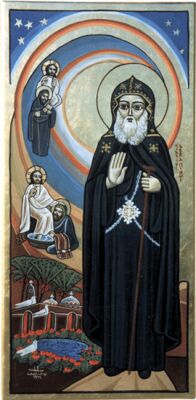Pishoy
Saint Bishoy (Paisios the Great) | |
|---|---|
 Coptic Icon of St. Bishoy, including scenes from his life | |
| Bishoy, Star of the Desert, Beloved of our Good Savior | |
| Born | 320 Shansa,Egypt |
| Died | 15 July 417 Mountain ofAnsena,Egypt |
| Venerated in | Eastern Orthodox Churches Eastern Catholic Church Oriental Orthodox Churches |
| Majorshrine | Monastery of Saint Bishoy Scetes,Egypt |
| Feast |
Eastern Catholic Church
|
| Attributes | MonkcarryingJesus,Monkwashing the feet ofJesus |
Bishoy of Scetis(Coptic:Ⲁⲃⲃⲁ ⲠⲓϣⲱⲓAbba Pišoi;Greek:Ὅσιος Παΐσιος ὁ Μέγας; 320 – 417 AD[1]), known in theCoptic Orthodox Church of Alexandriaas theStar of the Desertand theBeloved of our Good Savior,was aCopticDesert Father.He is said to have seenJesus,and been bodily preserved to the present day viaincorruptibilityat theMonastery of Saint Bishoyin theNitrian Desert,Egypt.He is venerated by theOriental Orthodox Churchesand theEastern Orthodox Church,and is known in the latter under the Greek version of his name, Paisios.[2]
Life
[edit]Bishoy was born in 320 AD in the village of Shansa (Shensha or Shesna), currently in theEgyptiangovernorate ofAl Minufiyah.Younger to six other brothers, he was weak and frail. His mother saw anangelin a vision asking her to give God one of her children, and pointed at Bishoy. When the mother tried to offer one of her stronger children, the angel insisted that Bishoy was the chosen one.
At the age of twenty, Bishoy went to the wilderness ofScetesand became amonkby the hand ofPambo,who also ordainedJohn the Dwarfa monk. When Pambo died, Bishoy was guided by anangelto the site of the present Monastery of Saint Bishoy, where he lived the life of ahermit.At this time, he became the spiritual father of many monks who gathered around him. He was famous for his love, wisdom, simplicity and kindness, as well as for his extremely ascetic life. He was also known to love seclusion and quietness. Bishoy's asceticism was harsh to the extent of tying his hair and hands with a rope to the ceiling of his cell, in order to resist sleeping during hisnight prayers.This asceticism made him so famous that he was visited byEphrem the Syrian.
TheCoptsbelieve that Bishoy sawJesusa number of times. When Bishoy's brethren learned that Jesus was coming, they gathered at the top of a mountain so that they might see him. On the way, they met an old man that asked these monks to help him on his way but they ignored him. Bishoy saw the man and carried him on his shoulders, only to discover that the old monk was none other but Christ himself. The latter told him that, for the extent of his love, his body will not see corruption. TheCoptsalso believe that Bishoy washed the feet of Jesus who visited him as a poor stranger.
Bishoy is known as a defender ofOrthodox faithagainstheresies.Having heard of an ascetic in the mountain ofAnsenawho taught that there was noHoly Spirit,Bishoy went to him carrying a weaved basket with three ears. When the old man asked him about the reason for making three ears for a basket, Bishoy replied "I have a Trinity, and everything I do is like the Trinity". After much debate from the Scriptures, theOldandNew Testaments,the old ascetic reverted to Orthodoxy.
Departure and relics
[edit]In 407/408 AD, as theMazicesinvaded the wilderness ofScetes,Bishoy left and dwelt in the mountain of Ansena. At this time, he metPaul of TammahinAntinoöpolisand the two became very close friends. While at the mountain of Ansena, Bishoy built another monastery, the monastery of Saint Bishoy atDayr al-Barsha,which still stands today nearMallawi.Bishoy departed on 8Epip(July 15) 417 AD.
On December 13, 841 AD (4Koiak),Pope Joseph I of Alexandriafulfilled the desire of Saint Bishoy and moved his body (as well as that of Paul of Tammah) to theMonastery of Saint Bishoyin the wilderness of Scetes.[3]It is said that they first attempted to move the body of Saint Bishoy only, but when they carried it to the boat on theNile,the boat would not move until they brought in the body of Paul of Tammah as well.[4]Today, the two bodies lie in the main church of the Coptic Orthodox Monastery of Saint Bishoy in theNatroon Desert.Eyewitnesses recount that the body of Bishoy remains in an allegedly incorruptible state to this day.
Monastic namesakes
[edit]There are currently three monasteries inEgyptthat carry the name of Saint Bishoy:
- TheMonastery of Saint Bishoyat theNitrian Desert
- The Monastery of Saint Bishoy atDeir el-Bersha,near Mallawi
- TheMonastery of Saint Bishoy at Armant,east ofArmant
TheRed MonasterynearSouhagis also named after anEgyptiansaint calledBishay.This saint is not to be confused with Saint Bishoy.
References
[edit]- ^Vivian, Tim; Mikhail, Maged S. A. (2022).The Life of Bishoi: The Greek, Arabic, Syriac, and Ethiopic Lives.American University in Cairo Press.ISBN978-1-61797-999-6.
- ^"Paisios the Great"Archived2010-06-20 at theWayback Machine,Online Chapel, Greek Orthodox Archdiocese of America, retrieved 12-10-2009
- ^Orthodox Monastery of St. Bishoy the Great - Wadi El-Natroun, Egypt
- ^"Lives of Saints: Baba 7".copticchurch.net.Retrieved2018-03-17.
- Coptic Orthodox Synaxarium (Book of Saints)
- Bishoy from Coptic.org
- Bishoy from copticchurch.net
- Bishoy from stmaryscopticorthodox.ca

